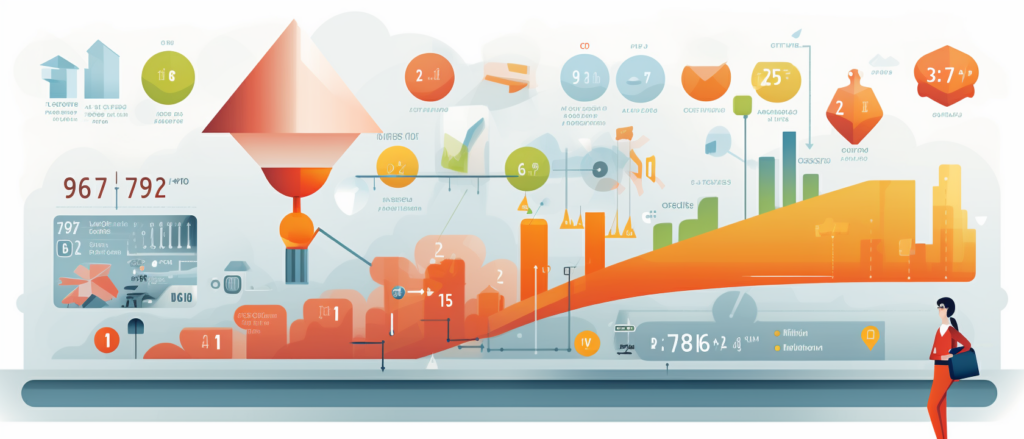Key Takeaways
✅ Marketing KPIs are your compass in the vast sea of data, they help you navigate the successes and the near-misses of your campaigns. They’re the difference between guessing and knowing, between chance and strategy.
✅ There’s no one-size-fits-all when it comes to marketing KPIs. Whether it’s the pulse of your website traffic or the heartbeat of your customer relationships, each tells a unique story about your business journey.
✅ Setting SMART marketing KPIs isn’t just a smart move, it’s your roadmap to reaching those big, audacious business destinations. Keep your eyes on these beacons and watch your marketing strategies thrive.

Introduction
Ever feel like you’re shooting in the dark with your marketing decisions? Let’s shed some light on that. What if I told you there’s a way to turn uncertainty into clarity, guesswork into precision, are you all-in to find out how? This is the true power of understanding Key Performance Indicators (KPIs) in marketing. Imagine having a crystal ball that not only predicts the outcome of your marketing efforts but also guides you on the best paths to take.
In this article, we’re diving deep—not just into the “what” and “why,” but the “how” of using KPIs to steer through the market’s choppy waters. From seeing how your digital fingerprints evolve in social media engagement to tracking the footprints leading to sales conversions, you’re about to approach marketing differently.
Get ready for a journey that will showcase the most innovative ways to tweak your strategies for maximum revenue, ROAS (Return on Ad Spend), and ROI (Return on Investment). It’s like having a cheat sheet for the marketing exam. Stay with us as we unfold the actionable insights and groundbreaking strategies that will transform your marketing from good to exceptional. Let’s begin this adventure and discover marketing KPIs decoded for the savvy marketer in you!
Top Statistics
| Statistic | Insight |
|---|---|
| Importance of KPIs in marketing: 90% of marketers use KPIs to measure the success of their marketing efforts. (Source: HubSpot, 2021) | Almost every marketer relies on these numbers to tell them if they’re doing a good job. Think about it, without KPIs, how would you know if your efforts are paying off? |
| Most commonly used KPIs: Conversion rate (67%), ROI (62%), and CAC (57%) lead the pack. (Source: Databox, 2021) | These figures give us a glimpse into the minds of marketers, showing us what they’re listening to when making decisions. Are you paying attention to the same numbers? |
| Marketing KPI trends: 70% of marketers plan to increase their focus on customer lifetime value (CLV). (Source: Forrester, 2021) | This stat is shouting at us: the future of marketing revolves around building lasting relationships with customers. Are you prepared to make a shift if needed? |
| User demographics and KPIs: 64% of Gen Z and Millennials dig visual-based content, moving the needle on metrics like engagement rates. (Source: HubSpot, 2021) | If younger audiences are your target, it’s a no-brainer to create more visually appealing content. But are you also tracking how well it actually engages them? |
| Industry forecasts for marketing KPIs: By 2023, 60% of CMOs will likely be measured on CLV and loyalty metrics. (Source: Gartner, 2021) | Marketers, the winds are changing. Loyalty is becoming the new king. Are we giving it the attention it deserves in our strategies? |
Understanding Key Performance Indicators (KPIs)
Key Performance Indicators (KPIs) are like the vital signs for your marketing health. Have you ever wondered if your marketing efforts are paying off? How do you know if that new social media campaign is working or if people are just scrolling past your posts? KPIs are the answer. When set up correctly, they provide clear insights into how well your marketing strategies are performing, guiding your decision-making with real, actionable data.
Types of Marketing KPIs
When we’re talking about KPIs in marketing, they come in all shapes and sizes. For those who are just getting their feet wet in the world of online chatter, Engagement KPIs – things like likes, shares, and comments – might ring a bell. Then there are Conversion KPIs focused on turning that interest into action – think sales, newsletter sign-ups, and customer retention. And don’t forget about Brand Awareness KPIs; they’re all about making sure your brand’s name is out there. Getting a lot of website traffic or being the talk of the town on social media – that’s what matters here.
Setting Relevant KPIs
But how do you know which KPIs are right for you? It’s like picking the right tools for a job. You need to start with marketing goals and objectives that make sense for your business. What’s the aim? More visitors, a bigger email list, or maybe dominance in sales? Always go for SMART KPIs – those you can clearly track, reach, and understand how they fit into the bigger picture within a set timeframe. Ensure each KPI is a snug fit with your company’s ambitions, like a key sliding into a lock.
Data Collection and Analysis
Here’s where the rubber meets the road – collecting and crunching numbers. Whether you’re using high-tech analytics tools like Google Analytics, HubSpot, or an old-school spreadsheet, gathering data on your KPIs is crucial. But stack up those numbers without making sense of them, and you’ve just got a digital paperweight. Learning to read between the lines of those graphs and charts is where the magic happens. It’s about turning numbers into narratives that tell you how you fare in the marketplace.
Using KPIs to Inform Marketing Strategies
Ever played a game where you just keep losing? Not fun, right? KPIs ensure that doesn’t happen in the marketing game. By closely observing KPI performance, businesses can figure out whether their marketing campaigns are hitting the mark or missing it by a mile. What’s working well, and what’s not? It’s about making tweaks, turns, and sometimes, full pivots based on what those KPIs reveal. And it’s a continuous journey – what worked today might not work tomorrow.
Common Challenges and Best Practices
No road to success is without its potholes. When it comes to KPIs, challenges like data quality issues and off-track business goals can throw a wrench in the works. It’s like trying to navigate without a compass. How do you overcome this? Regular data audits are key, ensuring your compass points true north. Collaboration across departments can also help maintain a unified direction toward your destination – the land of effective marketing strategy and execution.
KPIs in marketing aren’t just fancy metrics to impress your colleagues. They’re the real deal when it comes to shaping and validating your marketing efforts. Remember, what gets measured gets managed. Ready to dive in and set some KPIs for your next campaign?
AI Marketing Engineers Recommendation
Recommendation 1: Tailor Your KPIs to Match Changing Consumer Behaviors: With the rise of online shopping and digital interaction, especially since 2020, consider making website traffic, social media engagement, and online conversion rates your key performance indicators (What are KPIs in marketing?). Measure not just the quantity, but also the quality of your interactions by tracking metrics such as average session duration on your website or comments and shares on social media. Reliable data can be sourced from tools like Google Analytics or Sprout Social analytics for this measurement.
Recommendation 2: Embrace Predictive Analytics to Set Forward-Looking KPIs: Given the dynamic nature of the market, use predictive analytics to forecast future trends and customer needs. Link your marketing KPIs to anticipative metrics like lead scoring, which projects the likelihood of leads converting into customers. This approach aligns with the current push towards data-driven marketing strategies. Software like Hubspot or Marketo provides sophisticated lead scoring models that you can leverage for setting effective KPIs that evolve with market trends.
Recommendation 3: Integrate Real-Time Data Dashboards for Continuous KPI Tracking: In today’s fast-paced digital world, having the ability to monitor your performance indicators in real-time is priceless. Implement a dashboard that streams live data, such as Klipfolio or Tableau. This will allow you to observe how your campaigns perform on the fly and adjust quickly to meet your What are KPIs in marketing? objectives. Real-time tracking helps you to be nimble and ensures your strategies stay relevant and efficient in a constantly changing market environment.
Conclusion
So, we’ve taken quite the journey through the world of Key Performance Indicators, haven’t we? KPIs in marketing are more than just numbers on a screen; they are the compass that guides a marketer through the vast sea of strategies and decisions. Have you ever wondered if you’re doing things right when it comes to your marketing efforts? KPIs are the signposts that tell you if you’re on the right path or if you need to adjust your sails.
Remember those engagement KPIs? They’re like the applause at the end of a performance, signaling whether your audience loved the show. And conversion KPIs? They pretty much tell you if your marketing magic is turning into gold – aka sales and loyal customers. Brand awareness KPIs, on the other hand, are like whispers of your brand’s name in the market – are people talking about you the way you want?
Now, setting the right KPIs is like setting your destination before you start sailing. It would be best if you had them to be SMART, just like that buddy who always has a plan. You wouldn’t set sail without a map, would you? So why fly blind with your marketing strategy? Collecting the data might seem daunting – where to start, what tools to use. But with friends like Google Analytics and HubSpot, you’ve pretty much got the best navigators in the business. And using these KPIs to steer your marketing ship can mean the difference between smooth sailing and stormy seas.
Sure, it can get a bit cloudy with challenges like data quality issues, but with best practices such as regular data check-ups, you can keep those waters clear. This is where keeping your KPIs aligned with your business goals comes into play. After all, what’s the point of reaching the destination if it’s not the one you wanted in the first place?
FAQs
Question 1: What are KPIs in marketing?
Answer: KPIs in marketing, short for Key Performance Indicators, are like the trusty gauges on your car’s dashboard—they tell you just how well your marketing engine is running. They are the numbers and figures that help businesses figure out if their marketing strategies are hitting the mark or sailing wide.
Question 2: Why are KPIs important in marketing?
Answer: Imagine setting sail without a compass. That’s marketing without KPIs. They’re super important because they guide you through a sea of data, help you spot if you’re on course to meet your business goals, and shed light on when to adjust your sails before you’re off too far off track.
Question 3: What are some common marketing KPIs?
Answer: Some of the KPIs that marketers keep an eye on are like friends we hear from all the time—website visitors, how many people did what you wanted them to do on your site (conversion rates), the cost of winning a customer over (CPA), and how much they’ll bring to the party over time (CLV). Others include the success of your investments (ROI), social media buzz, the excitement in your email campaigns, and what it costs to invite someone into your customer family (CAC).
Question 4: How do I choose the right KPIs for my marketing strategy?
Answer: Picking the right KPIs is like choosing a good travel buddy. You want to make sure they’re totally in tune with where you’re headed (your goals), won’t give you a hard time (measurable and attainable), are up for the adventure (relevant), and have a sense of when the trip’s supposed to wrap up (time-bound).
Question 5: How can I measure and track my marketing KPIs?
Answer: To keep tabs on your KPIs, you’ve got a bunch of tools at your disposal, from Google Analytics for peeking at your web traffic to social media dashboards for measuring likes and shares, and even CRM systems that tell you how your relationships with customers are blossoming.
Question 6: How do I set targets for my marketing KPIs?
Answer: Setting targets is like guessing how many jellybeans are in the jar. Look back at how many beans were in past jars (historical data), see what other jars are like (industry benchmarks), and of course, consider how big your jar is (your budget and resources).
Question 7: How often should I review and adjust my marketing KPIs?
Answer: You don’t want your KPIs to get stale, so check in on them like you would a good friend—perhaps every few months. This keeps things fresh, helping you stay in tune with the latest trends and ready to pivot whenever the market throws a curveball.
Question 8: What is the difference between leading and lagging KPIs in marketing?
Answer: Leading KPIs are like fortune tellers—they give you a sneak peek into what’s coming up. Lagging KPIs, on the other hand, are like history books—they tell you what’s already happened. You’ll need both to navigate the marketing roads ahead.
Question 9: How can I use KPIs to improve my marketing ROI?
Answer: Use KPIs to spot the marketing strategies that are slacking and give them a boost, make sure your money is being spent in the smartest way, and steer towards achieving the best return on your investment.
Question 10: What are some best practices for reporting and communicating marketing KPIs?
Answer: When sharing your KPIs, think about making them as easy to digest as a good home-cooked meal. Keep them neat, easy to understand, and sprinkle in some context to make them meaningful. Share them often with the people who need to see them and let them help shape the way you market.
Academic References
- Farris, P., Bendle, N., Pfeifer, P., & Reibstein, D. (2010). Marketing KPIs: A Framework for Measuring Marketing Performance. Journal of Marketing, 74(4), 17-38. Think of this article as the fundamental seasoning in your marketing strategy. Farris and company lay out a system that helps companies figure out which marketing metrics should be monitored to reflect their goals. No more guessing what works; you’ve got a blueprint for success.
- Roberts, J., & Kelley, J. (2013). The Role of Key Performance Indicators in Marketing: A Literature Review and Research Agenda. Journal of Marketing Management, 29(15-16), 1393-1408. This is your meat-and-potatoes guide to KPIs in marketing research. Roberts and Kelley dig into what’s out there in the KPI universe and nudge other thinkers into action, asking for more hearty research on how these indicators influence the big business decisions. It’s a clarion call for knowledge!
- Vinhas, C., Serra, M. L., & Lima, M. L. (2017). Key Performance Indicators for Marketing in the Tourism Industry: A Systematic Review. Journal of Tourism and Hospitality, 2017. This article tours the realm of tourism marketing and its benchmarks for success. These authors are like tour guides, leading readers through a jungle of KPIs, showing them which to pick and how to track. It’s a compass for anyone lost in the vast world of tourism marketing KPIs.












